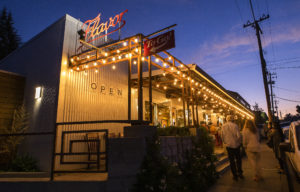 Food stamps have arrived at the farmers market. Since May, the Healdsburg and Petaluma Farmers Markets have begun swiping EBT cards — electronic debit cards used in lieu of food stamps — in return for locally grown fruits, vegetables and meats. Santa Rosa and Sebastopol also plan to join.
Food stamps have arrived at the farmers market. Since May, the Healdsburg and Petaluma Farmers Markets have begun swiping EBT cards — electronic debit cards used in lieu of food stamps — in return for locally grown fruits, vegetables and meats. Santa Rosa and Sebastopol also plan to join.
The first to accept the Electronic Benefits Transfer cards was the Healdsburg Farmers Market. Petaluma began accepting the cards in June, and the Santa Rosa market at the Veteran’s building and Sebastopol market will follow suit on August 14th and 15th respectively.
Here’s how it works: the market manager swipes the card, directly deducting the amount from the buyer’s account in exchange for tokens that can only be used at the farmers market. The tokens are used to buy food from the purveyors, who trade them in for cash at the end of the market day.
“A lot of food stamp offices have been hoping this would happen for a long time because they want clients to have access to healthier foods. In poorer neighborhoods, it’s fast foods and mini-markets, and access to fresh foods just isn’t there,” said Lisa Mann, a department analyst at the Sonoma County Human Services Department. “The sad fact is that Top Ramen is cheaper than organic produce. But for long-term health benefits, it’s obviously important to eat healthier,” she added.
Seen as a nutrition-assistance program for low-income individuals often prone to obesity and unhealthy eating, SNAP (Supplemental Nutritional Assistance Program) advocates are working hard to motivate and educate people about the benefits of eating fresh food from their local farmers.
The Healdsburg market is a test case for the local program, and market manager Mary Kelley said she’s getting two to three food stamp recipients at the market each week.
“People are coming here to find things that are unique or unusual, and they want to be part of the community spirit. They come with their families,” said Kelley, who adds that she’s seeing a cross-section of demographics, including college grads who have lost or couldn’t find jobs in the recent economy.
With the average enrolled family receiving just $288 in assistance per month, many in the food world agree that fresh foods can seem out of reach both financially and geographically.
“Packaged food is cheap, because the government subsidizes cheap foods. But we want people to know that they can afford food at the farmers market, and farmers want to make this work,” Kelley said.
As additional incentive, the Healdsburg and Santa Rosa markets have set up funds to match EBT amounts. For example, someone who spends $10 at the Healdsburg market will get an additional $10 in tokens to spend there. At Santa Rosa, they will get $5 for the first $10 spent. These funds have been created through personal donations to the market, which Kelley and Santa Rosa and Sebastopol market manager Paula Downing hope will continue to be replenished.
“I’m optimistic, but there’s a high educational and learning curve,” said Downing.
The Santa Rosa market will feature a luncheon for EBT card users on August 14, along with cooking demonstrations and recipes for using market foods in English and Spanish.
Local youth from the VOICES program and CHOPS teen club, which serve underprivileged youth, are also expected to get involved with the Santa Rosa program.
“When you involve people in the business of food, they don’t have to eat out of a package,” Downing said.
Concerns over increased bookkeeping and administrative expensees – the wireless card-system alone costs $1,000 – threatened to derail the program as a state bill requiring California farm markets to accept electronic food stamps cards by 2012 began making its way through the state Legislature in February. It now resides in the Senate.
But the U.S. Department of Agriculture (USDA) has since agreed to shoulder the cost of the card systems. Healdsburg’s Kelley acknowledges she’s putting in several hours of extra bookkeeping for the handful of food stamp clients she’s seen each week at the market. But she is so far encouraged by the program.
Refuting the idea that farmers markets are more expensive, Kelley said that while some produce may be commanding a premium, most everyday seasonal produce is comparable or even less that that in grocery stores.
“So much of supporting farmers markets is about changing habits,” she said. “I want people to get over misconceptions that we’re more expensive.”
In Sonoma County, there are currently more than 20,000 individuals participating in the federal food stamp program, including 14,000 children. Local enrollment has grown by more than 65 percent in the past two years. Nationwide, 40.2 million American rely on food stamps, according to USDA statistics. According to the Sonoma County Human Services Department, nearly all local benefits are spent locally and stay in the community.
“Our local farmers and farmers markets get the benefits of these dollars and low-income families have a chance to purchase fruits and vegetables so fresh they might have been picked from the farm that morning. Everybody wins,” said Marion Deeds, Director of the Economic Assistance Division within the Sonoma County Human Services Department.
Farmer’s Markets now accept food stamps
Low-income individuals can use benefits for marke food









